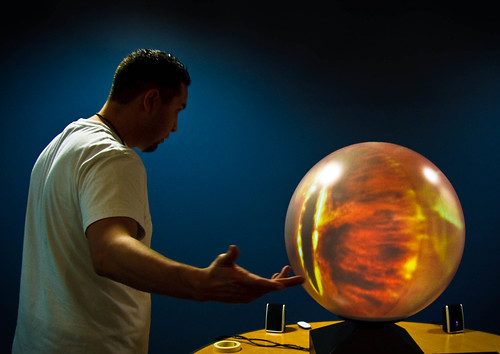
Michael Augustin is a former ETC student (and former Apple employee, and former intern at Three Rings) and the CEO of startup company Gendai Games. The name "Gendai Games" is very appropriate to the company's philosophy and business model, because "Games" in an English word meaning "activity engaged in for diversion or amusement." He came to speak with us last week.
Game Salad, Gendai Games' current project, is a tool to help non-programmers create games. Broadly, the toolset gives the user a "salad bar" of video game basics with which to make a game, things like "life meters" and "keyboard navigation" and "croutons." The user puts these elements together however he likes, in a user interface so friendly-looking that you'd swear Michael used to work at Apple like I already said he did.
But the thrust of Michael's presentation wasn't his project per se, but the experience of creating a startup. The first lesson? 99% of startups fail. Aww.
Other lessons include:
-The creation of a values hierarchy - the priorities that detemine your culture, your method, and your product.
-Positioning yourself in the market so that you're not in a footrace with existing, established products.
-Connecting with your audience - "make a blog before you make a business plan" goes the inter-wisdom - in other words, put your idea into the light of day and see if it survives.
-Networking. Except don't call it "networking" while you're doing it. "Aren't we having fun networking, you and me?" No, that doesn't go over well.
-Being on a startup team means being prepared to wear many hats (and, if you're really into the role, many false mustaches). Michael has been, at various times in his startup life, an accountant, a quality assurance tester, an HR rep, a web developer, a programmer, and, currently, a CEO.
-OODA. According to Wikipedia, "OODA" is "Ōda, Shimane (Redirected from Ooda)." But according to Michael (and military strategist John Boyd), it's "Observe, Orient, Decide, Act." What it boils down to is a commitment to a quick work cycles and overall company agility. Apple, he notes, has an eighteen-month develoment cycle, while Windows Vista had a four-year cycle. Windows, you'll notice, is just now mounting a response to the "I'm a Mac / I'm a PC" ads. Come on, guys.
-It will generally take longer to do anything than you think it will. User experiences, specifically, take longer to polish the more the user will exprience them. In Super Mario Bros., for example, the experience of jumping had to be perfect, while the encounter with the princess, which the player only experienced once, could just go ahead and suck.
-"Income - expenses = profit." I am SO GLAD someone told me this. I was putting a plus sign in there this whole time.
-Various ways to get money for your startup, including venture capital, bootstrapping (using one's own money) and "angel" investors, individuals who provide money for the fledgling business.
And that was Michael's startup lesson in a nutshell. Now YOU know more than eighty percent of startups. Not enough to beat the 100-to-1 odds every time, but it's a good start.
Game Salad drops in early 2009.







